How to Get Verified on Facebook in 2022
Facebook has a real problem with fake accounts.
In the third quarter of 2021 alone, this social media channel removed over 1,8 billion fake profiles, and the peak was back in 2019, with over two billion pages:
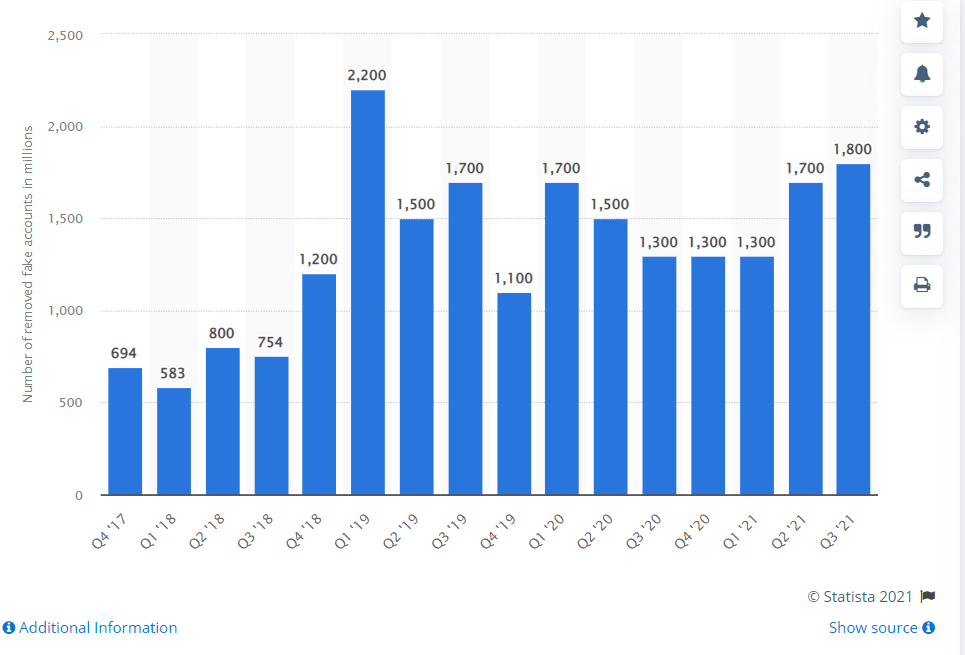
Among such accounts, there are plenty of fake company accounts. Most of the time, these impostors are harmless – they are usually fan pages trying to spread the word about their favorite brands.
However, sometimes, such profiles can really hurt your reputation, especially if they broadcast misinformation and fake news about your business.
So, if you don’t want to face such an unpleasant situation, you need to get your Facebook account verified.
Aren’t sure how to do that?
No worries – we have all the answers in our step-by-step guide. Let’s take a look.
What is a Verified Account on Facebook?
A verified account on Facebook is a profile that has been confirmed to officially represent a brand’s authentic presence on this platform. When Facebook verifies an account, it gets a blue checkmark next to the brand’s name.
It is possible to verify a Facebook Business page as well as a personal profile.The blue badge differentiates authentic pages from imposter accounts.
The platform introduced the page verification feature in 2013. It is a solution helping Facebook single out real accounts and decrease the number of fake ones.
If your page gets a verification badge, you cannot transfer ownership or change the purpose of your profile. According to Facebook, every edit to the account (such as name and bio modifications) needs an additional review. If you attempt to transfer ownership, the badge will be removed.
There are a few requirements for an account to receive the verification badge. We put all of them in a graph for your convenience:
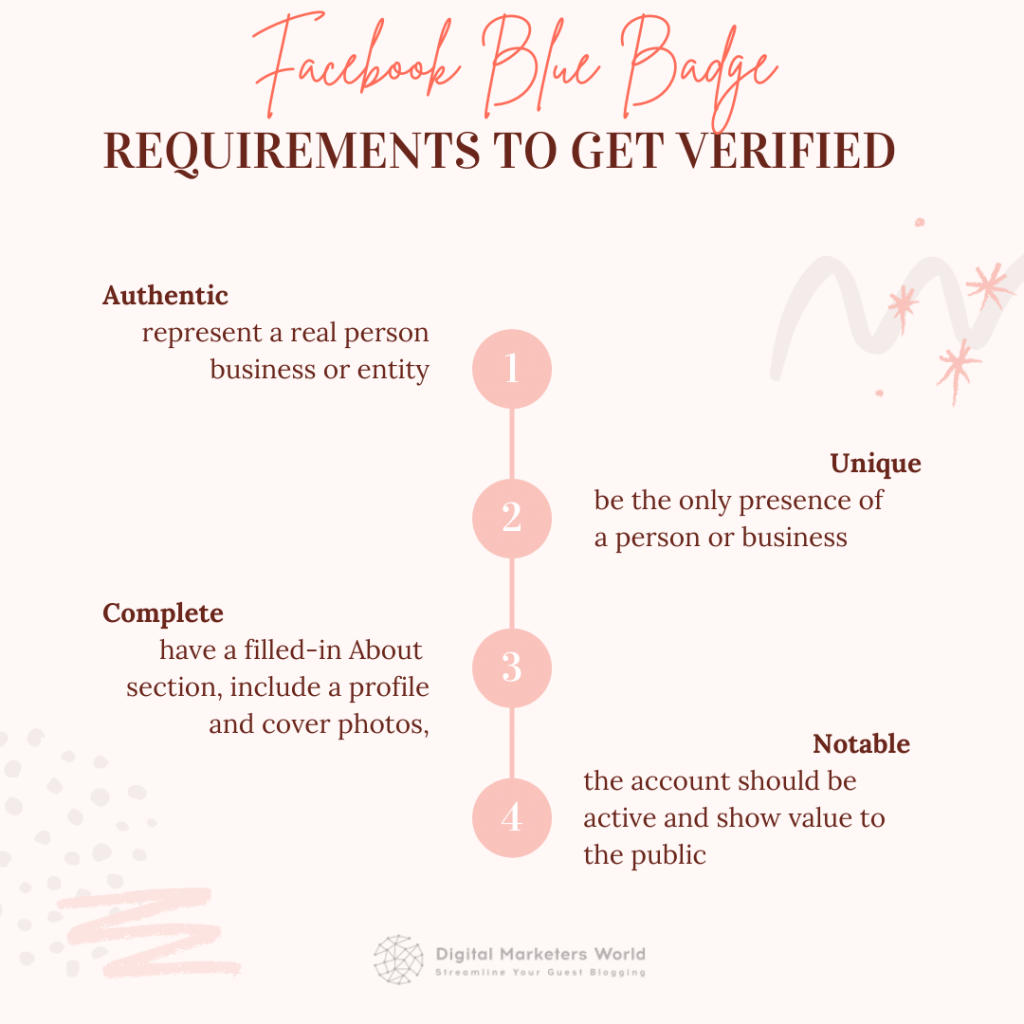
So, to round up these verification criteria:
- Your profile should belong to a real person, registered business, or other venture.
- The account should be the only presence of your brand online.
- You should fill in all the required information.
- Your page needs to represent a well-known person or entity.
To get a verification badge, you need to complete a form, but we’ll talk about it in detail a bit later.
Blue Verified Checkmark
So, we already mentioned that Facebook gives you a blue badge symbolizing that your page is, in fact, credible. If you type in the name of your favorite brand on Facebook, you will most likely see a checkmark, while all third-party pages won’t have this verification sign:
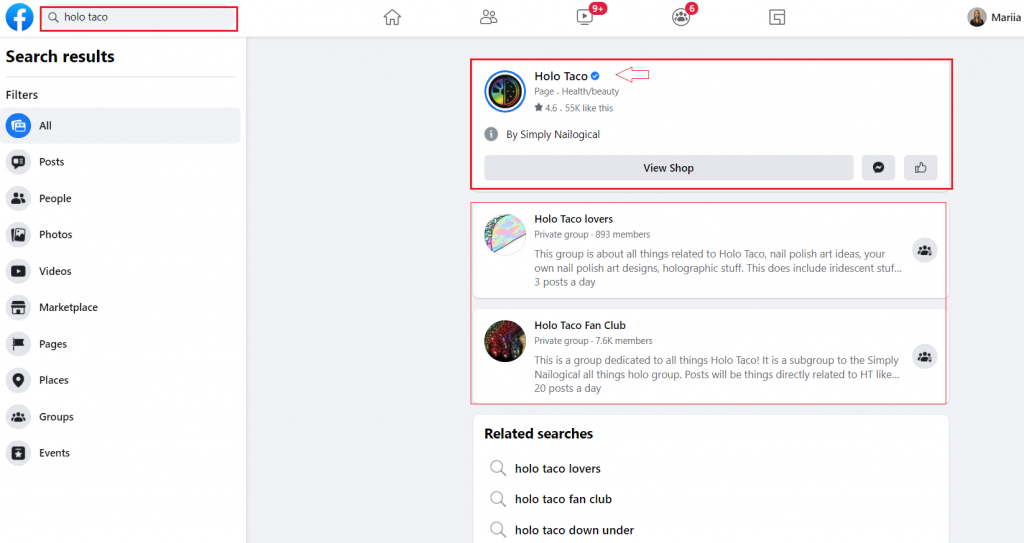
Who else can get a blue verification checkmark?
If you’re a public figure or an influencer, you can also file a request to get a Facebook page verified. There are many accounts of celebrities with a blue checkmark:
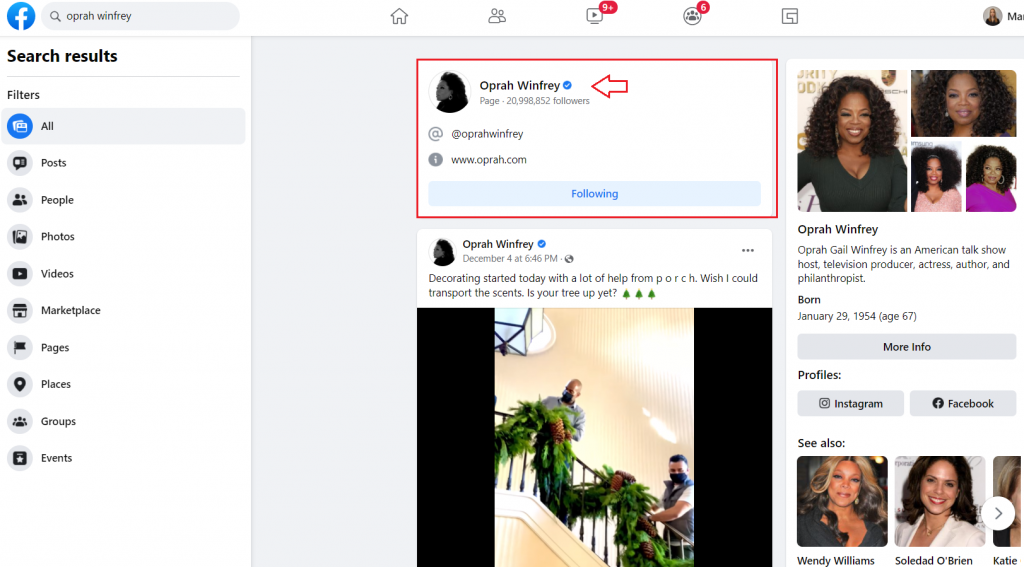
Basically, this verification symbol will follow your account everywhere on Facebook:
- On your page
- In Facebook Search
- In the comments you leave on other accounts
It will also help differentiate you from accounts pretending to be you or representing your brand.
Why is this important?
There have been cases in the past when such accounts spread misinformation, which ended up hurting a company’s reputation. The latest situation involved Wells Cargo, whose own employees created fake profiles using the names of real customers, signing them up for credit card accounts. The company ended up paying $3 billion to settle criminal charges.
So, an activity involving fake accounts, both within and outside your organization, can really harm your business. However, if you apply for account verification, it can save you from such unpleasant situations.
It is also worth mentioning that Facebook initially had two verification symbols – a blue and a grey verified checkmark. Personas and brands with the gray verification badge had the right to request account verification as they had been confirmed authentic by Facebook. The grey badge was discontinued in 2019.
4 Reasons for Getting Your Facebook Account Verified
We’ve mentioned that a blue tick next to your brand’s name can protect your business and strengthen your online reputation. However, these are not the only advantages of applying for verification.
Let’s look at a few more reasons to fill in the form and get proof that your Facebook profile is authentic.
Reason #1: Increase credibility
In theory, when a user sees a verification mark on an account, the credibility of this page should go up. After all, the information on this profile has been verified, and the posts it makes can be trusted.
But is it entirely so?
Research says not really. For instance, a study from Georgetown University has explored the verification effect on users (on Twitter, but regardless) and found that the blue checkmark does not impact their perception of a brand’s credibility.
The research participants rarely cited the verification symbol as a must for the brand’s trustworthiness and didn’t take it into account when sharing the content from such pages.
That said, the study also mentions another poll, which delivered completely opposite results. Its participants were 100% sure that account verification is a factor impacting their perception of a brand’s online presence.
So, which conclusion can we draw?
We should take the results from any research with a grain of salt. The study participants from Georgetown University were young, and we can assume they are better at differentiating trustworthy Facebook accounts. Moreover, the study took place during the proliferation of ‘fake news’ around the internet in 2019, and people were suspicious of even the most credible sources.
Let’s conclude: a verification mark does improve your credibility, especially if someone wants to cite or tag your brand accounts on Facebook (or anywhere else on the internet).
Reason #2: Increase followers
It can be a real bummer if a fake Facebook page steals potential followers from you. Then, you will have a hard time convincing them to subscribe to your real account, and there is no guarantee they will follow you.
Thus, make sure your account gets verified as soon as possible. It will help you start growing your follower base faster and outrun all imposter profiles.
It’s also worth mentioning that verified pages appear higher in Facebook Search:
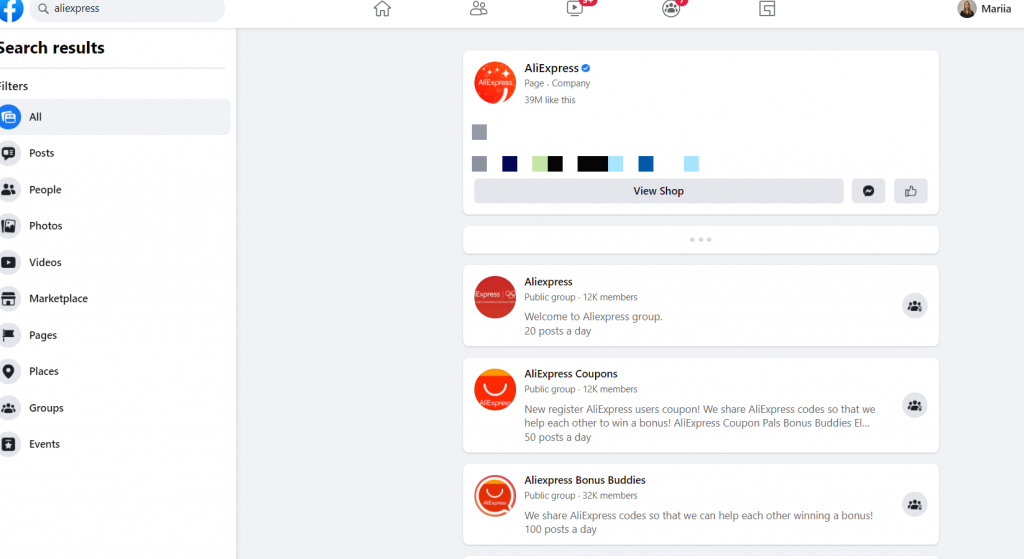
As a result, when a person searches for your brand on this platform, your verified profile will appear at the top, prompting them to visit and subscribe.
Besides, we’ve already figured that a verification checkmark adds credibility to your profile. The same goes for the content people see on your page. When a post is made on a verified Facebook page, people see it as a sign of trust and will be more likely to like, share, and comment, increasing activity on your page.
Reason #3: Improve online presence
It’s hard to find a person who doesn’t research a brand before purchasing a product. According to Google, 53% of online shoppers study the brand’s online presence, but the actual number is definitely much higher. Brand research, of course, involves social media, too.
If you have a verified checkmark, the person will be prompted to visit your profile right away. However, the symbol alone will not satisfy their needs, so pay attention to the content you post and how it represents your business.
We also already mentioned that accounts with confirmed authenticity appear at the top of Facebook search results. However, the same happens with SERPs in Google:

So, don’t disregard this opportunity to help your brand rank better in search results. It is your chance to improve your online visibility and help potential customers find you easier. It’s also one of the reasons why social media is better than traditional marketing – you have all the chances to become more discoverable.
Reason #4: Regain lost impressions and mentions
Every Facebook post on a business account gets impressions – a number of views or engagements. You can track them through Facebook Insights along with Reach:
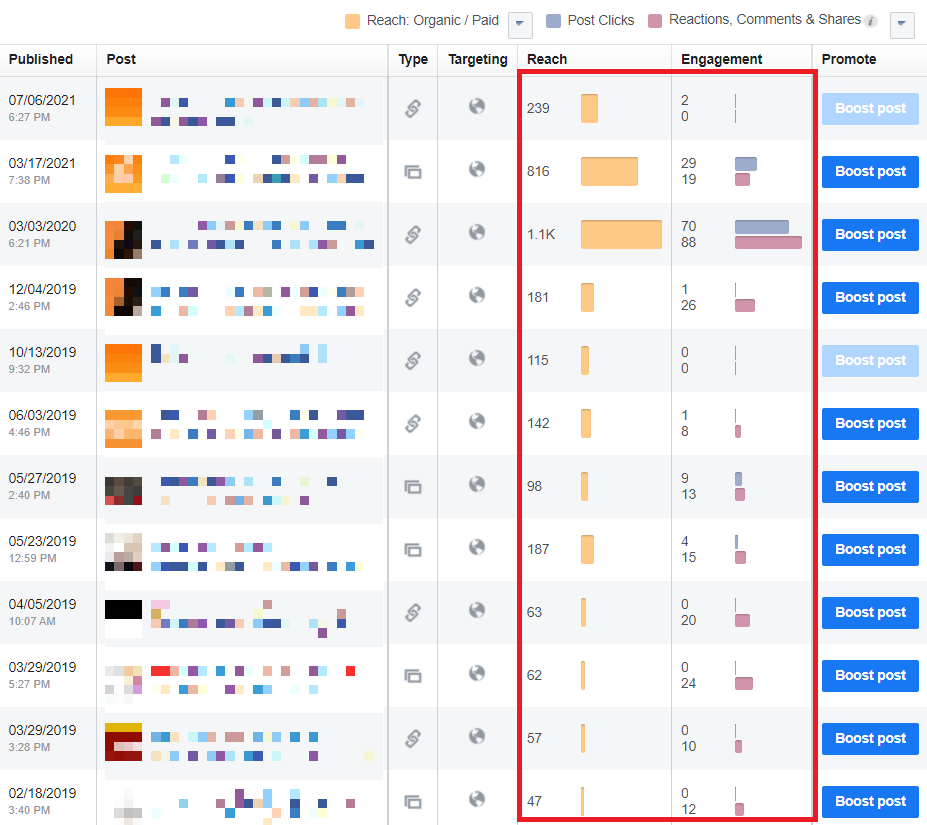
If your profile is not verified, you may be losing impressions to fake accounts. It can also be a reason why your posts are underperforming.
So, apply for account verification as soon as possible to improve brand visibility and awareness.
An 8-Step Process to Get a Verified Checkmark
Have we convinced you to finally get yourself that blue verification symbol on your Facebook page?
Good! Now, let’s discuss how to do it step-by-step.
Overall, the process is not very hard, but you need to keep in mind a few essential requirements that will speed up the process of getting verified.
Step #1: Start by visiting the Profile Verification page
Your go-to page is Verify Your Profile, which you can find in Facebook Help Center or access through Facebook Business Manager:
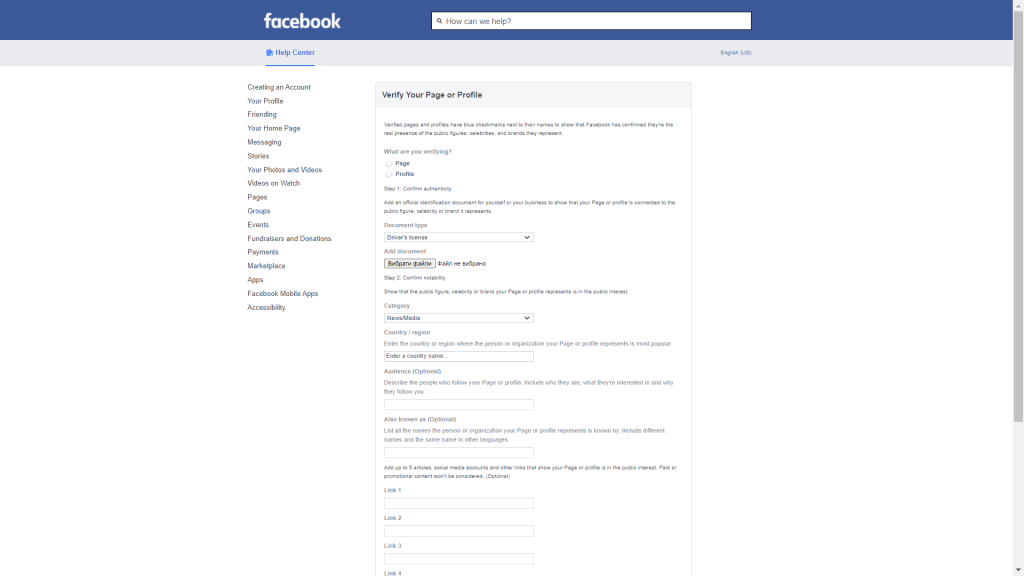
There, you will see various sections, which you need to fill out with the most relevant, up-to-date information.
Step #2: Choose an account for verification
On Facebook, there are two options you can consider for verification – a public page or a profile:

In both cases, you need to have quite a few followers to be eligible for the blue check.
How many followers?
There is no such information in the official Facebook guidelines, but the number should be no less than 500 to apply for verification.
Moreover, it is worth mentioning that the whole process of checking profiles is more complicated and lengthy than with pages. And yes, you can apply for a verified checkmark with a personal profile. Simply insert the link to your account after checking the respective option.
Step #3: Confirm that you are a real person
Obviously, you can’t get a confirmation of account authenticity if you do not provide proof that it belongs to a real human being.
During the verification process, Facebook will give you several options for official documents to identify yourself: driver’s license, passport, national identification card (a photo ID), tax exemption documents, recent utility bill, or articles of incorporation (a certificate of formation that establishes the existence of your brand):
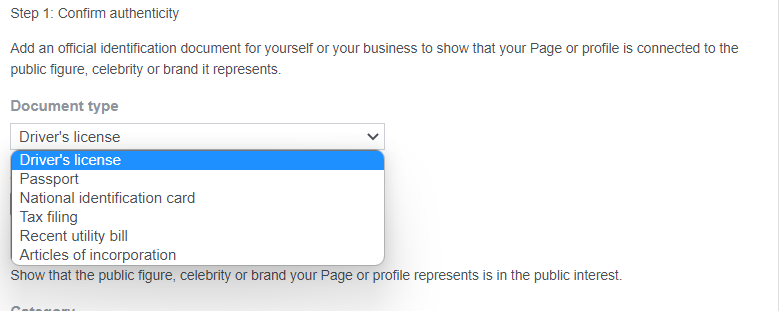
You need to upload the documents in one of these formats: .pdf, .png, and .JPEG.
Step #4: Choose the category of your profile or page
The next step is confirming your notability, which involves picking the category that characterizes your account. It is necessary for Facebook to confirm public interest.
There are several category options you can choose from:
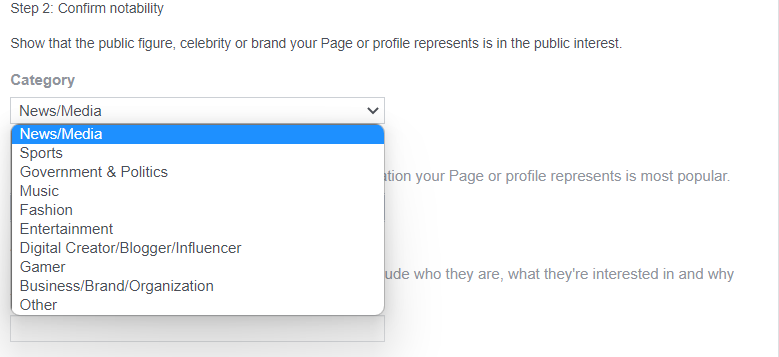
If none of these options are relevant to what your page is about, opt for Other. In this case, Facebook might ask you to provide more information separately.
Step #5: Select your country or region
Your location is a basic requirement for verification. Facebook (and many other social networks) needs it to understand your brand’s influence better.
Simply start typing the name of your country or region, and choose from available options:

At this point, we’re through with the must-do tasks for Facebook verification. Now, we’ll talk about several optional points, but they are necessary if you want to get verified faster.
Step #6: Describe your audience
To help Facebook verify you, provide additional details about your followers. You should be specific about who they are, what are they interested in, and why they are following you:

To increase your chances of getting verified, use real-life data from Facebook Insights, Hootsuite and its alternatives, or other social media tracking tools. You don’t want to make baseless claims – Facebook reps who will review your profile need actual proof of the demographic and psychographic information.
Step #7: Provide details to confirm your brand’s online presence
If your organization goes by different names, you may want to mention that in the verification form. This is especially important for the brands that use several names for different markets. However, this step is not necessary.
Finally, you can add links to other official pages and accounts from social media channels to showcase your overall online presence:
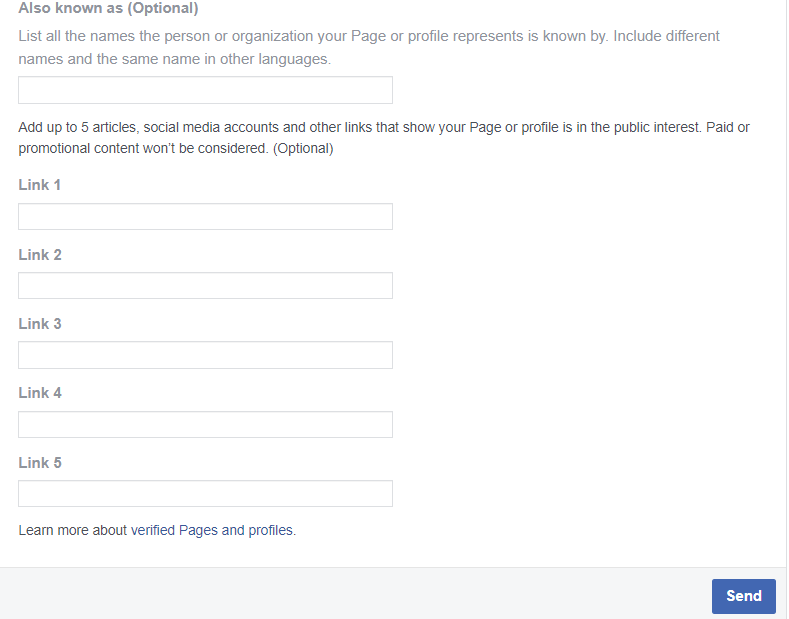
Note that you should not provide any promotional links, as Facebook will not consider them credible.
Once you’re done filling in the form, you can request verification.
Step #8: Get patient and wait
It can take Facebook up to 45 days to verify your account. However, in some cases, profiles get checked within 48 hours, but there is no way to tell for sure. So, the only thing you can do is wait and, if things get stuck, keep in touch with customer service.
What if Facebook rejects your verification request?
If such a thing happens to you, your first task is to go and check whether your profile contains all the information needed for verification. Here’s the list of the details that should be up-to-date:
- Brand name that follows Facebook guidelines
- Cover photo
- Profile photo
- Address
- Phone number
- Official website
- High-quality content
- Followers (no less than 500)
Local businesses can also add maps and the price range for their products or services.
There is also a chance that the document you provided to verify your authenticity did not satisfy Facebook reps. In this case, try alternative options or ask Facebook support to guide you.
What are other reasons for rejection?
It is possible that your profile is not active enough to get a blue verification checkmark. For example, the followers on your account don’t comment, like, or repost your content.
If your verification request gets denied, you can reapply in 30 days. Within this period, dedicate some time to improving your Facebook page, working on creating content, and expanding your follower base.
Apart from that, it won’t hurt to talk directly to Facebook about the reasons why you got a rejection. Such decisions aren’t usually kept in the dark, considering that you have the full right for a blue checkmark. So, stay in touch with the support while also working hard on making your Facebook presence more consistent.
Bonus: 3 Tips to Increase Your Chances of Getting (& Staying) Verified on Facebook
As you can see, the verification procedure on Facebook is pretty standard. However, there are a few things you can do to improve the likelihood of getting and remaining verified.
Wait, Facebook can take away a blue verification mark from you?
It sure can. If any information you provide on your account is false and no longer corresponds to what you’ve stated in the verification form, Facebook will remove the checkmark. Apart from that, according to the original source, your account may even get deleted.
So, you might need to take extra steps to secure your verification badge. We have some tips for you, and don’t worry – all of them are legit.
Tip #1: Keep it professional
If you are considering verifying your page, then you must be planning to use it professionally. If you’re using your account for Facebook marketing, your presence on this platform should correspond to your intentions.
What do we mean by that?
Your activity on your profile should be consistent and in line with your branding strategy. Your account should contain everything needed for a potential follower to understand what you do and the things you offer.
Here are a few essentials of building a professional Facebook profile:
- Your profile and cover photos should be recent and represent your brand.
- All account information should be filled in with relevant information.
- A professional account has a customized URL.

- Content on your page should showcase your brand’s values.
- Your account should look active – there should be comments, shares, likes, reactions, etc.
Surely, Facebook support will evaluate your profile activity during the verification process. Your task is to show that you really take pains to deliver value to your followers.
Tip #2: Keep your business info up-to-date
We’ve repeatedly mentioned throughout the article how important it is to have an updated About section with all your business information. And, the more details you provide, the more points it will add to your verification score.
So, which essential business details should the About page include?
It depends on the type of venture. However, you can see the bare minimum you need to provide on the example below:

Review this information from time to time. Otherwise, Facebook can take the verification badge away from you.
Tip #3: Connect your other social media accounts
When filling in the verification form, you can add links to other social media profiles you’re using for your digital marketing strategy. However, you can also tie them to your Facebook page for faster access:
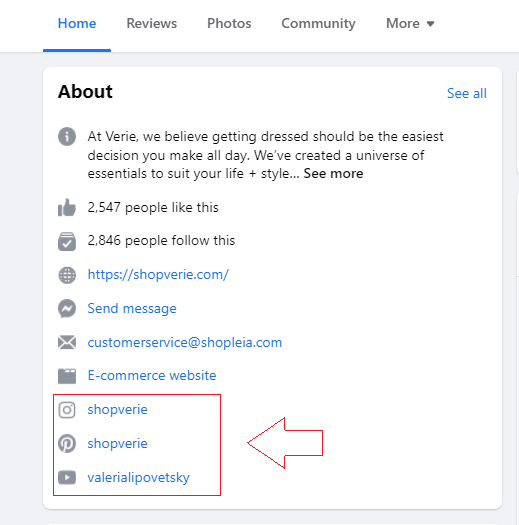
Connecting other social media accounts can also help verify your Facebook faster, especially if your Twitter or Instagram accounts already have a verification checkmark.
Now Over to You
As you can see, getting proof of authenticity for your Facebook page is not that hard. The process is very straightforward. Let’s recap it one more time:
- Go to the Facebook Page Verification page
- Choose the account for verification (page or profile)
- Submit the documents confirming you’re a real person
- Choose the profile/page category
- Select the country/region
- Describe your audience
- Add details that prove your brand’s online presence
Once you’ve done everything, all you have to do is wait. Your verification request can get denied, and, in this case, you need to wait 30 days to resubmit.
To avoid this unpleasant experience, make sure all the business information on your profile is relevant and updated, your page is active, and your content delivers engagement. Keeping your profile professional increases your chances of getting verified considerably.
Interested in learning more about social media marketing? Keep reading our blog – we’ve got fresh articles coming every week!
Frequently Asked Questions (FAQs)
Do you still have unanswered questions about Facebook verification? Let’s clarify some of the most popular ones.
Q1. Is it free to get verified on Facebook?
Facebook verification is free of charge. You don’t need to pour money into Facebook ads or pay extra to get the badge. Your main task is to keep your account looking professional and consistent with your branding strategy.
Q2. How many followers do you need to get verified on Facebook?
Although Facebook doesn’t give an official answer to this question, some resources claim you need at least 500 followers to get the blue verification badge. Or, simply put, your account should be active enough to confirm it satisfies general interest and has public value.
Q3. Can a normal account get verified on Facebook?
If you mean a personal account, yes, it can get a verified badge. However, all accounts applying for verification must comply with Facebook’s Terms of Service and Community Standards, have an up-to-date profile and cover photos, and a page name that follows Community Guidelines.

Mariia is a content strategist and editor at Digital Marketer’s World. She is passionate about educating others on all things marketing and believes in the power of the written word.
